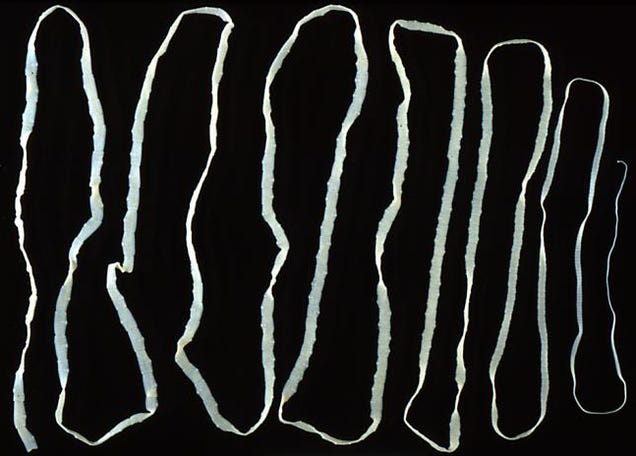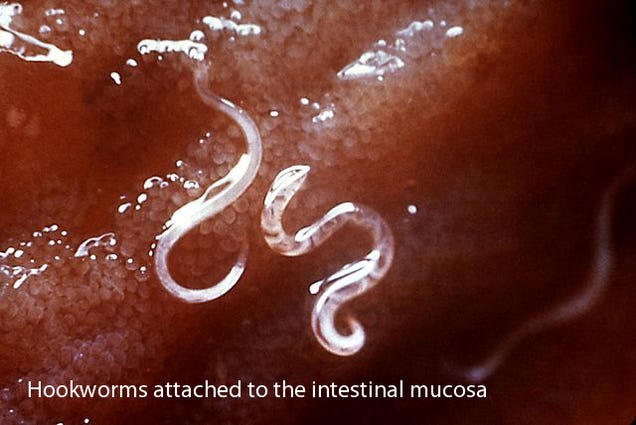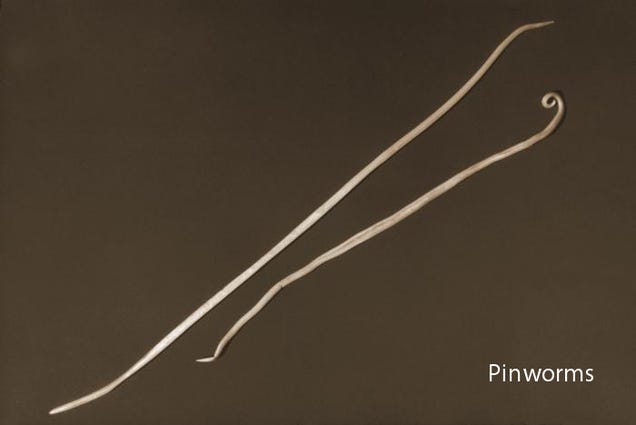Parasitic worms are the stuff of nightmares — worms as big as twelve feet long can rummage through your intestines, and then leave in the middle of the night. Urban legends tell tales of tapeworms carried by diet pills. Some of the weird schemes for removing these parasites include a combination of duct tape, candy bars, and bodily orifices.
What is the reality behind these parasites? And how can you really get rid of one, without the need for extreme measures?
Top image: Tapeworm art by Damnations_Shadow/Flickr.
Tapeworms hide in your food
Obtaining a beef or pork parasite is rather easy, but also easily avoidable. Undercookedmeat is a common way to ingest both Taenia solium and Taenia saginata, whose larvae often live inside pigs and cows. Either species of tapeworm can grow up to twelve feet and live inside of a human host for several years.
Obtaining a beef or pork parasite is rather easy, but also easily avoidable. Undercookedmeat is a common way to ingest both Taenia solium and Taenia saginata, whose larvae often live inside pigs and cows. Either species of tapeworm can grow up to twelve feet and live inside of a human host for several years.
Tapeworms can cause a variety of health problems, including seizures, obscured or blurry vision, and a swelling of the brain if larvae move to that region. Most infections are asymptomatic, however, with the patient only realizing they are harboring a tapeworm when they pass a wiggling section of the worm while defecating. Manual removal of a tapeworm through the mouth is also possible, but not fun.
Hookworms lay traps in the soil
The hookworm is much smaller than a tapeworm. These parasites are rarely more than acentimeter long, and burrow into your small intestine to feast on your blood. Since hookworms latch onto your small intestine and divert nutrients away from the bloodstream, they're actually more problematic than tapeworms. Hookworm infection can lead to anemia, slower cognitive growth, and malnutrition.
The hookworm is much smaller than a tapeworm. These parasites are rarely more than acentimeter long, and burrow into your small intestine to feast on your blood. Since hookworms latch onto your small intestine and divert nutrients away from the bloodstream, they're actually more problematic than tapeworms. Hookworm infection can lead to anemia, slower cognitive growth, and malnutrition.
Hookworms infect over a billion people worldwide. The vast majority of these people live without advanced sanitation, amidst subtropic and tropical climates. Transmission of hookworms is quite devious and more involved than tapeworm transmission. When the soil cools off at night, hookworm larvae extend out of the soil, waiting to latch onto any human foot that passes overhead. Local sanitation problems come into the equation when larvae are passed through feces, allowing them to infect humans through both direct contact and contaminated water.
Pinworms sneak out of your anus at night
Tiny pinworms lay eggs around a host's anus, leading to an itching sensation, which creates a vicious cycle if your fingers come in contact with your mouth — since this allows the eggs to enter the digestive tract.
Tiny pinworms lay eggs around a host's anus, leading to an itching sensation, which creates a vicious cycle if your fingers come in contact with your mouth — since this allows the eggs to enter the digestive tract.
Pinworms are found worldwide, and they're the bane of many North American elementary schools, as infections often begin through human contact or through recently used surfaces like toilet seats, faucets, and doorknobs. Thankfully, the symptoms of a pinworm infection are not nearly as severe as a hookworm invasion, — the worst pinworm symptoms include itchiness, irritability, and weight loss.
A common test for pinworms involves taping the anal region of a possible host, and inspecting the tape for eggs after a good night's sleep. (If you can sleep in that condition.) Pinworms don't just travel to the anus and lay eggs as part of a cruel joke — they need access to fresh air for their eggs to mature.
Killing the unwelcome guests within
A number of pharmaceutical treatments are available to rid humans of unwelcome worm guests. These drugs are called anthelmintics — and this includes several different types of drug, each with different methods of killing worms. (Prior to the development of small-molecule pharmaceuticals, people used to eat tobacco, pineapple, and honey to rid the body of worms.)
A number of pharmaceutical treatments are available to rid humans of unwelcome worm guests. These drugs are called anthelmintics — and this includes several different types of drug, each with different methods of killing worms. (Prior to the development of small-molecule pharmaceuticals, people used to eat tobacco, pineapple, and honey to rid the body of worms.)
Benzimidazoles are the largest and most versatile class of anthelmintics. This class of drugs starves the worms by cutting off their ability to absorb glucose. Benzimidazoles bind to the protein beta-tubulin, which disrupts any processes that make use of microtubules.
Albendazole is the MVP of this class of drug — it works against pinworms, hookworms, tapeworms, and a variety of other worm infections. The broad spectrum application and low cost of albendazole makes it a first-line defense against parasitic worms.
Ivermectin is an increasingly important drug used for treating parasitic infections. Ivermectin interferes with a parasite's neurotransmitters, paralyzing the invaders indiscriminately, and eventually leading to death.
Unfortunately, Ivermectin does not work against tapeworms, but the drug's method of action allows it to eliminate most intestinal worms, as well as external parasites like scabies and lice. Patients can also wait threemonths to a year between doses of ivermectin. The infrequent dosage and wide scale application of ivermectin make it the anthelmintic of choice for treatment of parasites in Third World countries.
Albendazole and ivermectin are only two of a legion of available anthelmintics. But just like antibiotic-resistant infections, we're starting to see parasites that have resistance to anthelmintics. That's why there's a wide variety of other drugs to fight parasitic worms. But any strategy for fighting parasites has to include more personal hygiene and sanitation, as well as dosing family members with anti-parasite drugs — as these worms tend to pass from family member to family member.
Tapeworm, pinworm, and hookworm images are from the CDC Public Health Image Library. Sources linked within the article.
2 77







ليست هناك تعليقات:
إرسال تعليق